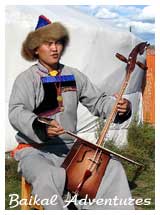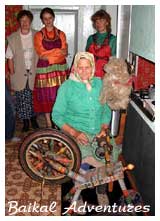|
|
People.
 The
Buryats are a Mongolian people of Southern Siberiawho belong to the Central
Asian type of the larger Mongolian ethnic group. Their primary settlement
area is located east and west of Lake Baikal, in the Sayano-Baikal Mountains,
in East Transbaikalia, and in the southeastern part of the central Siberian
plateau. The Buryats who live in the area west of Baikal are often called
Prebaikalians; and east of it - Transbaikalians. The
Buryats are a Mongolian people of Southern Siberiawho belong to the Central
Asian type of the larger Mongolian ethnic group. Their primary settlement
area is located east and west of Lake Baikal, in the Sayano-Baikal Mountains,
in East Transbaikalia, and in the southeastern part of the central Siberian
plateau. The Buryats who live in the area west of Baikal are often called
Prebaikalians; and east of it - Transbaikalians.
The Buryat language belongs to the northern subgroup of the Mongolian
branch of the Altai language family. It can further be divided into numerous
dialects in the different regions of Buryatia.
Livestock husbandry, the main occupation of the Buryats from the 17th
century to the beginning of the 20th century, has determined their way
of life as well as the characteristic features of their material and spiritual
culture. In the 17th century nomadic (in Transbaikalia) and semi-nomadic
(in Prebaikalia) cattle breeding by and large defined their livelihood.
Hunting and agriculture only played a subsidiary role, and the level of
development largely depended on raising livestock. The traditional dwelling
of the Buryats is the felt yurt. Meat and dairy product dishes dominate
their traditional cuisine.
tour
programme
 The
Old Believers –descendants of the dissenters (Raskolniks) –
are a group of Russian peoples living in Transbaikalia. A significant
part of them lives in the Bichurskii, Tarbagataiskii and Muhorshibirskii
regions of the Buryat Republic in Russia. However, Old Believers also
live in other regions of Buryatia (Chitinskii region), in the USA (Alaska
and Oregon) and in Poland. The
Old Believers –descendants of the dissenters (Raskolniks) –
are a group of Russian peoples living in Transbaikalia. A significant
part of them lives in the Bichurskii, Tarbagataiskii and Muhorshibirskii
regions of the Buryat Republic in Russia. However, Old Believers also
live in other regions of Buryatia (Chitinskii region), in the USA (Alaska
and Oregon) and in Poland.
During the reign of Tsar Alexei Mihajlovich in the middle of the 17th
century, the Russian Orthodox Church experienced a schism. After the reforms
in the years 1653-1660, the church officially accepted the changes of
patriarch Nikon.
Conservative dissenter,- or Old Believers, are defined as the part of
the Russianpeople who refused to accept the reforms and continued performing
old ceremonies and praying habits. Because of their dissent, they became
subjects of persecution. In order to escape from persecution, the Old
Believers were forced to leave their homeland and secretly settle in the
Don, Volga and Ural regions.
A mass resettlement of Old Believers began after the decree of Catherine
the Great, in which she allowed them to return to Russia and settle in
the remote territories of Siberia.
The
Old Believers settling in Transbaikalia called themselves "Semeiskie"
(originating from the Russian word for family, “semya”) because
they migrated with their whole families. They always tried to live independently
and far away frompeople of different faiths. From the date of resettlement,
they tried to preserve their ancestors’ customs and traditions,
closely following the doctrine of their ideological teacher Avvakum.
To
this day, the way of life, customs and dialect of the Old Believers have
not undergone any major changes. Theirgarb, brightly painted houses and
ancient songs are very distinctive and of special beauty. The traditional
cuisine consists of vegetable dishes, forest products, meat dishes, as
well as delicious beverages prepared from wild berries.
tour
programme
The Evenks – also called Tungus, are the native population
of Transbaikalia. They inhabit the territory from the left bank of the
Yenisei River up to the Okhotski Sea and from the polar tundra to the
Angara and Amur Rivers. Their origin stems from the Pribaikalia and Transbaikalia
regions, from which they spread out to their present-day places of residence.
Prior to modern times, they led a nomadic life. Their main occupations
were hunting, fishing, and reindeer breeding. They also mastered blacksmithing,
carving, and skin tanning; and made boats, skis, sledges, and domestic
utensils from wood and birch bark.
Evenks
usually lived in nomadic tents covered with bark in summer and with deerskins
in winter. In the beginning of the 20th century, they started living a
more settled life. Along with traditional occupations, they also started
to develop agriculture and animal breeding. Today, they occupy the northern
part of the Buryat republic as well as the Kurumkanskii and Bauntovsky
regions.
tour
programme
Let's
go!
| |
